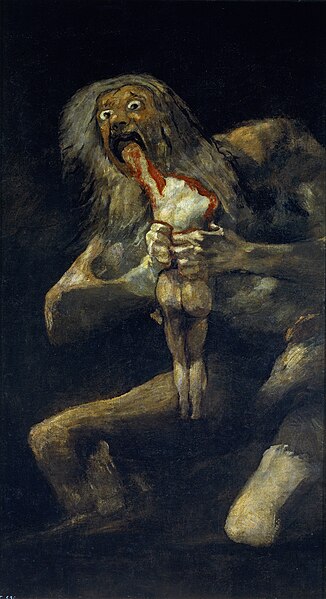I have always been interested in the way that a person’s artistic expressions reflect his/her life experiences.
Even though I don’t believe I am at the point, in my artistic skillset, to
entirely capture my emotions and personality, I find it fascinating to see how a
few great artists are able to do this. Last
semester I studied abroad in Spain and was fortunate enough to take an art
history class that allowed me to go to the Prado museum once a week. One of the artists that caught my interests
was Francisco Goya, who I thought concretely expressed his own life in his
paintings.
Goya was born in Fuendetodos, Aragon, Spain in 1746. He was quickly regarded as a skillful artist
and gained favor with the Spanish monarchy, however throughout his life he’s
always had a subversive imaginative element in his art. His portraits are nortable for their
disinclination to flatter (Voorhies). In particular
the painting Charles IV of Spain and His Family shows an incredible frank
portrait of the royal family. Goya is
almost satirical and shows the corruption of the royalty. He is not trying to flatter the family with
the portrait. I believe this shows is
initial discontent with society in Spain. (ibid)
I think that Goya continues to
show his discontent with Spanish society.
He frequently painted scandalous images, for example the first fully
nude life size portrait of a female in Western art. Later condemnation of Spanish society he
created a set of 80 prints called Los Caprichos. Some of the most famous of these happened
during the Napeoleonic Wars, showing Goya’s internal turmoil of the changing Spanish
government and cruelties of the War (Mcdonald). These
are a series called the Disasters of War.
The Third of May 1808 is shown below where Goya represents the
resistance to French forces (ibid).
At the end of his life, we can
see that Goya begins to have an embittered and dark attitude towards mankind. He became very ill multiple times, which
resulted in his deafness, and the stress from the death of his first wife is
believed to have made him reclusive and insane.
This led to his creation of the Black Paintings, which were extremely modern
and expressionist style that portrayed intense haunting themes. Additionally, these paintings were drawn on the walls of his country home, but then translated into prints (Kramer). This I believe is reflective of his insanity
and pessimistic outlook on humanity. One
of the most famous Black Paintings, Saturn Devouring His Sons, is shown
below. In this depiction the god Saturn
is eating his newborn sons out of fear that they will overthrow him. This also demonstrates the theme that time is
the devourer of all things and no one can escape it (ibid). Below is a sketch showing how he planned these dipictions, entitled Soldiers Fleeing a Phantom (ibid).
In conclusion, I find it
fascinating how we can follow the lives of amazing artists like Francisco Goya through their artwork,
from social discontent, to outrage, to pure insanity.
Bibliography
Krämer, Felix, and Roland Borgards. Dark
Romanticism: From Goya to Max Ernst. Ostfildern: Hatje Cantz, 2012. Print.
McDonald, Mark. Renaissance to Goya: Prints and
Drawings Made in Spain. London: British Museum, 2012. Print.
Voorhies, James. "Heilbrunn Timeline of Art
History -- Fransisco Goya." Francisco De Goya (1746–1828) and the Spanish Enlightenment. Metropolitan Museum of Art, n.d. Web. 26
Feb. 2013.



